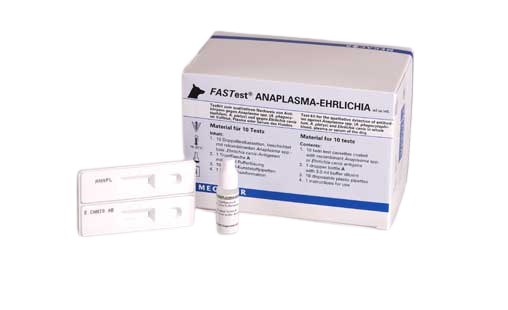Description
Qualitative detection of antibodies against Anaplasma spp. (A. phago-cytophilum, A. platys) and Ehrlichia canis
Test Applicable to: Dog
Sample: Whole blood, plasma or serum
Anaplasmosis & Ehrlichiosis -Tick Borne Threats to Dogs
Canine Granulocytic Anaplasmosis (GA, Anaplasma phagocytophilum [A. p.], Thrombocytic Anaplasmosis (TA, Anaplasma platys) and Canine Monocytic Ehrlichiosis (CME, Ehrlichia canis) belong to the most important vector-borne infectious diseases induced by canine parasites. Co-infections play a major role in both pathogens, therefore, depending on the animals’ place of origin and whereabouts, potential other pathogens (e.g., Borrelia spp., Babesia spp., Leishmania spp.) or laboratory values indicative of these pathogens (e.g., anaemia, leucocytosis / neutrophilia, hypoalbuminemia / hypergammaglobulinemia, kidney values etc.) should be clarified.
Breeding Grounds
In principle, tick territories (endemic area) are potential breeding grounds. Seroprevalences for GA / TA and CME vary widely, depending on country (endemic or non-endemic) and study.
Incubation Period & Symptoms
With an incubation time of 2–20 days, A. phagocytophilum infections are often subclinical or self-limiting. Clinical symptoms are fever, apathy, stiff muscle, polyarthritis with joint pain / swelling, lameness, weight loss, thrombocytopenia, anaemia, petechial haemorrhages and increasing inflammatory values (CRP, haptoglobin). Subarachnoid haemorrhage could lead to central nervous disorders. The cause of TA is A. platys. It occurs world-wide, mainly in the Southern Hemisphere. In most cases, the infection is asymptomatic with mild fever, uveitis, petechiae and ecchymoses. In the laboratory diagnostics, a thrombocytopenia is shown.
CME is characterised by a very long incubation period (Ø 4–5 up to 12–13 years) and an unspecific clinic. It is therefore also referred to as a “silent killer”!
Diagnosis
Very few veterinarians are aware of the consequences of such a co-infection from an immunological, therapeutic and diagnostic point of view. Therefore, FASTest® ANAPLASMA-EHRLICHIA is suitable as a quick, qualitative antibody detection if an anaplasmosis, ehrlichiosis or a co-infection is suspected. This enables to start immediately further diagnostic investigations as well as therapeutic and prophylactic measures.
FASTest Anaplasma-Ehrlichia Product Information
Why Test
Why it is important to test for Anaplasma & Ehrlichia
Anaplasma
Anaplasma phagocytophilum is a rickettsial intracellular bacteria that infects primarily neutrophils. It is transmitted by the tick Ixodes ricinus, found in the UK and throughout Europe.
Ehrlichia canis
Canine Ehrlichiosis is an acute to chronic disease due to the appearance of coccoid bodies in the cytoplasma in monocyte cells. Ehrlichia canis is transmitted by the brown dog tick, Rhipicephalus sanguineous. Although detected primarily near the Mediterranean Sea, it has also been detected in other regions of middle Europe, the Far East and the USA.
Symptoms
What are the symptoms of Anaplasma-Ehrlichia Canis
Clinical symptoms of Anaplasmosis are:
- Apathy
- Stiff muscles
- Fever
- Polyarthritis with joint pain
- Swelling
- Lameness
- Weight loss
- Thrombocytopenia
- Anaemia
- Petechial haemorrhages
- Increasing inflammatory values (CRP, haptoglobin)
- A subarachnoid haemorrhage could also lead to central nervous disorders.
The cause of thrombocytic anaplasmosis is Anaplasma platys, which occurs worldwide and the infection can have the following symptoms:
- Mild fever
- Uveitis
- Petechiae
- Ecchymosis
Ehrlichia Canis
The clinical signs of E. canis can be divided into three phases: acute, subclinical, and chronic.
The acute phase (early disease) occurs one to three weeks after the tick bite occurs. During this time, the E. canis bacteria is reproducing and attaching to white blood cells. The clinical signs typically seen in the acute phase are:
- Fever
- Lethargy/depression
- Anorexia/weight loss
- Enlarged lymph nodes
- Lameness
- Vomiting/diarrhea
- Cough
- Abnormal bruising and bleeding
- Neurologic signs, such as loss of balance or stumbling
If treated in the acute phase, most dogs will clear the infection completely and return to normal. Dogs that do not receive treatment will likely progress to the subclinical phase in weeks one to four.
In the subclinical phase, dogs will still be infected but show no signs of disease. The bacteria hide in the spleen where it can remain for months or years. The dog will have no clinical signs but may have some changes on bloodwork (a slightly low platelet count and possibly elevated blood protein called the globulin). Not all dogs will progress from the subclinical to the chronic phase as some dogs may clear the disease on their own.
In the chronic phase (long-term disease), the dogs were unable to eliminate the bacteria and will become sick again. Chronic phase clinical signs include:
Abnormal bleeding: Up to 60 percent of chronic phase dogs will have this symptom due to decreased platelet numbers which can lead to anemia.
Inflammation in the eyes (uveitis), bleeding in the eye (hyphema), or blindness
Neurologic signs, such as loss of balance or stumbling
Increased urinating (polyuria) and increased drinking (polydipsia) from damage to kidneys
Lameness/swollen limbs
Dogs in the chronic phase have a worse prognosis, and this phase can become fatal.
Advantages
Advantages of FASTest Anaplasma-Ehrlichia
- Simple test procedure with whole blood, plasma or serum
- Fast test interpretation after 10 minutes
- Reliable clinical diagnostics
- Anaplasma: Sensitivity 87.5 % & Specificity 100%
- Ehrlichia: Sensitivity 98.2 % & Specificity 100 %
- Storage at room temperature (15–25 °C)
- Long shelf life
- Compact test box with 10 tests


